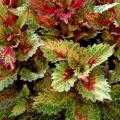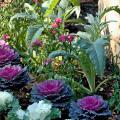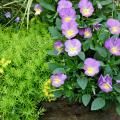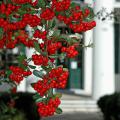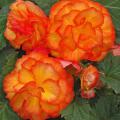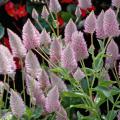Southern Gardening from 2008
By Norman Winter
MSU Horticulturist
Central Mississippi Research & Extension Center
The change in gardening seasons has given many gardeners a renewed enthusiasm for getting some dirt on their hands. One reason to celebrate the cool season is that it holds great promise for creating small perfume factories near outdoor areas where visitors gather or family frequents.
By Norman Winter
MSU Horticulturist
Central Mississippi Research & Extension Center
You'll be seeing the stars of next year's gardens and landscapes if you are among the thousands expected to attend the 30th annual Fall Flower and Garden Fest Oct.17-18 at Mississippi State University's Truck Crops Experiment Station in Crystal Springs.
By Norman Winter
MSU Horticulturist
Central Mississippi Research & Extension Center
The cardoon is a plant the Romans and Greeks ate as a vegetable, but today its popularity is sweeping the South as it is the newest Mississippi Medallion award winner.
Although the ancients ate it, at Mississippi State University's Truck Crops Experiment Station, we use it for its looks. Botanically, cardoon is Cynara cardunculus, and it is related to the globe artichoke.
By Norman Winter
MSU Horticulturist
Central Mississippi Research & Extension Center
Muhly grasses native to the southern United States offer dazzling performances for the fall landscape. One of the most picturesque is commonly called Lindheimer's muhly, or blue muhly.
The blue-gray-green color and fine leaf texture would make this grass a winner even if it never bloomed. But it does, sending up plumes on 4-foot-tall plants. The blossoms begin as a creamy pink that turns whiter and finishes tan.
By Norman Winter
MSU Horticulturist
Central Mississippi Research & Extension Center
An old masterpiece may be tucked away in your potting shed or garage just waiting for you to bring it to life. This masterpiece is an empty piece of old pottery or even a concrete planter with a chip or two missing and moss or lichens growing on it.
I saw a cool-season container like this a year or two ago that took my breath away. The designer had carefully placed the plant material to create a living work of art.
By Norman Winter
MSU Horticulturist
Central Mississippi Research & Extension Center
Pansies and violas are planted in the fall, and they bloom until late spring when temperatures get too hot. Without a doubt, these are the best value for your gardening dollar. They are so good that I wonder why some people don't take advantage of these colorful, workhorse-type flowers.
I attend the California Pack Trials each April and am always amazed by one group of pansies produced by a company called American Takii, located on the outskirts of Salinas.
By Norman Winter
MSU Horticulturist
Central Mississippi Research & Extension Center
Pinks or dianthus are among the most loved cool-season flowers. While they are described as cool-season flowers, varieties like the Amazon series perform in the cool season and for much of the summer, too, giving us combination possibilities we may never have considered.
By Norman Winter
MSU Horticulturist
Central Mississippi Research & Extension Center
You may have heard the term black gold in your lifetime. While it is most often associated with oil, gardeners worth their salt will associate the phrase with compost. Compost is that dark, crumbly, organic material that is often a prerequisite for the green thumb.
By Norman Winter
MSU Horticulturist
Central Mississippi Research & Extension Center
Winter is often cold and dreary, but the pyracantha, a member of the rose family, helps landscapes remain beautiful, interesting and a great source of food for cedar waxwings.
The pyracantha gets its name from the Greek word “pyr,” for fire, and “akanthos,” for thorn, hence the common name firethorn. This is very appropriate, as the pyracantha has sharp, painful thorns. I remember as a child reaching in to retrieve baseballs from the branches and coming out screaming.
By Norman Winter
MSU Horticulturist
Central Mississippi Research & Extension Center
With few flowers blooming, our landscape's main interest at this time of year comes from differing textures.
I recently stumbled on a combination planting that featured natives in an awesome show of texture. Had I kept my eyes open, I would surely have seen Mother Nature, rather than a landscape architect, do it first. Nevertheless it struck me as a partnership worthy of writing about and photographing.
By Norman Winter
MSU Horticulturist
Central Mississippi Research & Extension Center
A few Pennies can make your winter landscape look like a million bucks.
I'm not talking about the proverbial penny saved or even the penny found lying on the sidewalk. The Penny I am talking about is not copper-colored but perhaps a rich orange, deep blue or one of more than 20 other colors.
By Norman Winter
MSU Horticulturist
Central Mississippi Research & Extension Center
2009 looks to be the Year of the Begonia. This is not an official proclamation but my expectation of the incredible new begonias that will debut this spring. From hanging baskets to the landscape, begonia lovers can rejoice.
By Norman Winter
MSU Horticulturist
Central Mississippi Research & Extension Center
At this time of the year, some people look back and reflect and others look to the future. Joey, a hot new plant from Australia that is coming this spring, will have us looking to the future.
Pages
- « first
- ‹ previous
- 1
- 2
- 3


